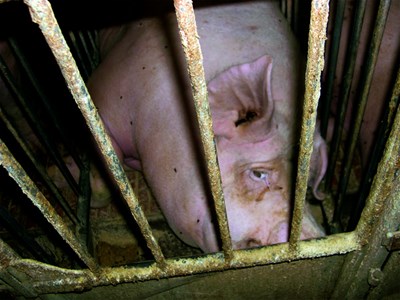Gestation crates

In much of the world it is common for pregnant sows to be kept in “gestation crates” (also known as “sow stalls”) for their entire 16-week gestation period. A gestation crate is a metal crate or cage, usually with a bare, slatted floor, which is so narrow that the sow cannot turn around and can only stand up and lie down with difficulty.
Gestation crates have been banned in Arizona, California, Colorado, Florida, Maine, Massachusetts, Michigan, New Jersey, Ohio, Oregon, and Rhode Island. Due to consumer pressure, a number of food companies are phasing them out voluntarily. Gestation crates are illegal in Sweden and the UK. In January 2013, they were banned across the EU, except for the period from weaning of the previous litter until the end of the first four weeks of gestation. A bare gestation crate prevents virtually all natural behavior and interaction with other pigs. Scientific research shows that gestation crates cause physical and psychological suffering to sows, including lameness due to weaker bones and muscles, abrasion injuries, cardiovascular problems, digestive problems, and urinary tract problems.
Gestation crates also increase abnormal behavior such as sham chewing and bar-biting, indicating severe frustration and stress, and sows in crates can exhibit behavior likened to clinical depression.
Feed is often restricted during pregnancy, causing chronic hunger and further increasing the level of frustration.
Farrowing crates

Within a couple of weeks of giving birth, sows are inseminated again (often artificially) and begin their next pregnancy. A commercial sow will normally produce two litters per year with approximately 10 to 12 piglets per litter. Her time as a breeder will last about three years before she is sold for slaughter.
Farrowing crates also severely restrict movement and frustrate sows’ strong motivation to build nests before giving birth. They prevent sows from being able to get away from their piglets if needed (for example, if they bite). It is common for piglets to have their teeth ground down or clipped, without anesthetic, to minimize biting injuries.
Farm conditions for growing pigs
Growing pigs are often kept in barren, crowded conditions on slatted concrete floors without straw for bedding or rooting. These pigs have no access to the outdoors and will never experience fresh air or daylight. They are unable to behave naturally and are likely to be bored and frustrated. They tend to fight and bite each other, sometimes causing severe injury.
In addition to tooth-clipping, most piglets have their tails docked to discourage tail biting. This procedure is painful and often causes long-term distress.
Stress, illness, and conflict often result when piglets are abruptly weaned and mixed with unfamiliar young pigs.
In most countries, nearly all male piglets are castrated. This is done to guard against “boar taint,” where chemicals present in pigs at puberty sometimes impart an odor and taste to their meat which many people do not like. There are no legal restrictions against pig castration in the US, some voluntary welfare certification programs do limit when it can be performed. For example, the Animal Welfare Approved standards allow castration of piglets who are less than 15 days old, and the Global Animal Partnership (GAP) 5-Step welfare standards allow castration at less than seven days old, and only by farms operating at GAP’s first 4 tiers. Pain relief is not mandatory.
Transport and slaughter
Pigs travel badly and are easily stressed by transport and pre-slaughter handling. They do not have sweat glands and are particularly susceptible to heat stress.
Internationally, significant numbers of pigs die each year in transport and in lairage (holding pens) at slaughterhouses as a result of stress.
There are higher welfare alternatives for pig farming.

